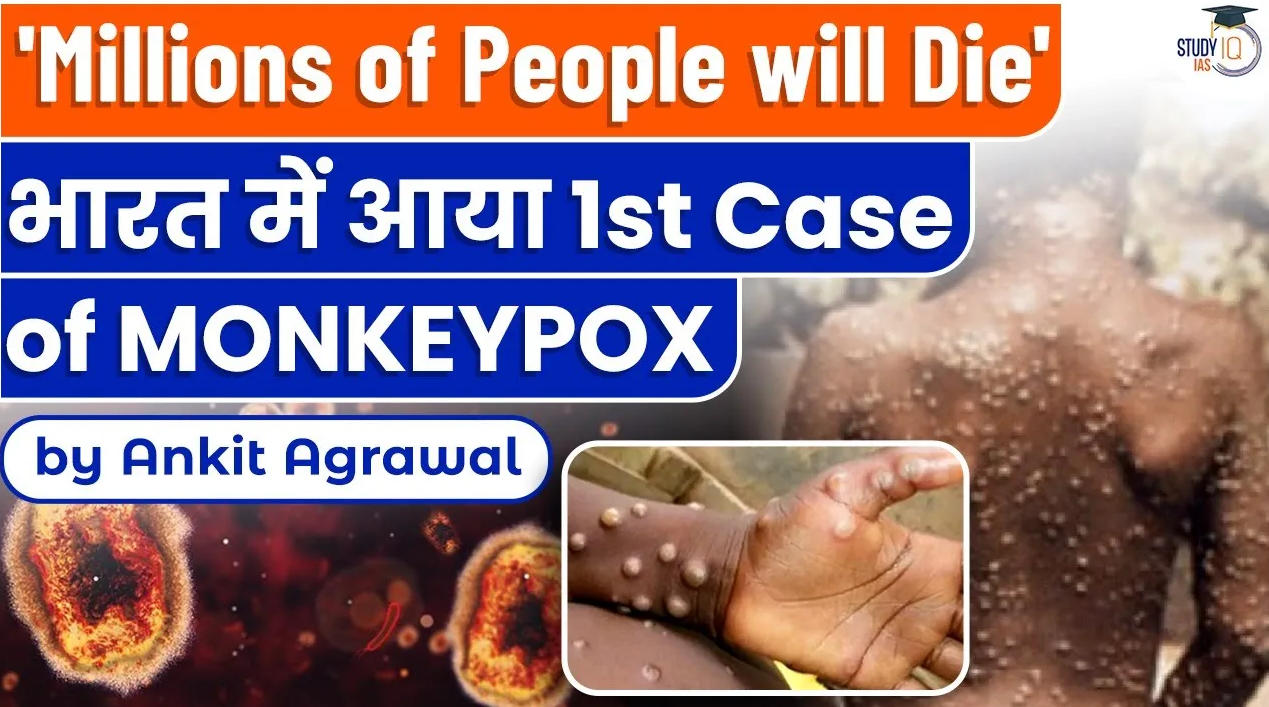Table of Contents
What has happened?
- The first case of monkeypox was confirmed in India on July 14, after a person who had returned to Kerala from abroad developed symptoms of the disease.
- According to Kerala Health Minister Veena George, the infection was diagnosed in a person who had returned from the United Arab Emirates three days ago and had come into contact
- with another confirmed case in the UAE.
- The person’s samples were tested at the National Institute of Virology in Pune, which confirmed monkey pox on Thursday, the minister said.

- With 3,417 confirmed Monkeypox cases reported across 58 countries, World Health Network (WHN) has announced that they are declaring the current monkeypox outbreak a pandemic.
- The outbreak is rapidly expanding across multiple continents and will not stop without concerted global action, it said in a statement.
- Even with death rates much lower than smallpox, unless actions are taken to stop the ongoing spread—actions that can be practically implemented—Millions of people will die and many more will become blind and disabled, it said.
- WHN said that the essential purpose of declaring Monkeypox a pandemic is to achieve a concerted effort across multiple countries or over the world to prevent widespread harm.
- “The WHO needs to urgently declare its own Public Health Emergency of International Concern (PHEIC)—
- The lessons of not declaring a PHEIC immediately in early January 2020 should be remembered as a history lesson of what acting late on an epidemic can mean for the world,“
- Said Eric Feigl-Ding, PhD, Epidemiologist and Health Economist, and co-founder of WHN.
What is Monkeypox?
- Monkeypox is a viral zoonosis (a virus transmitted to humans from animals) with symptoms similar to those seen in the past in smallpox patients.
- It belongs to the same family of smallpox although less severe than smallpox with lower infection.
- Monkeypox is caused by monkeypox virus, a member of the Orthopoxvirus genus in the family Poxviridae.
- Monkeypox occurs primarily in tropical rainforest areas of Central and West Africa and is occasionally exported to other regions.
What are the symptoms of monkeypox?
- According to CDC, after 12 days of contracting the virus one can experience fever, headache, muscle aches, and tiredness.
- The body starts developing rashes after 3 days of contact, with fever kicking in.
- The rashes spread throughout the body and can be extremely itchy, which goes through different stages while healing, forming a scab, and then falls off.
- The lesions can lead to scarring.
- The symptoms and illness last up to 2 to 4 weeks and are reduced on its own.
How does it spread?
- The suspected hosts of the virus are rodents, like rope squirrels, dormice, and pouched rats.
- It spreads through spill-over hosts such as monkeys and humans.
- If a person comes in contact with clothing, bedding, respiratory or direct contact of an infected person, they can possibly catch the virus.
- Typically, up to a tenth of persons ill with monkeypox may die, with most deaths occurring in younger age groups.
First case of Monkeypox?
- Human monkeypox was first identified in humans in 1970 in the Democratic Republic of the Congo (then known as Zaire) in a 9-year-old boy in a region where smallpox
- had been eliminated in 1968.
- Since then, most cases have been reported from rural, rainforest regions of the Congo Basin, particularly in the Democratic Republic of the Congo, where it is considered to be endemic.

- Since 1970, human cases of monkeypox have been reported from 11 African countries –
- Benin, Cameroon, the Central African Republic, the Democratic Republic of the Congo, Gabon, Ivory Coast, Liberia, Nigeria, the Republic of the Congo, Sierra Leone, and South Sudan.
- In 2017 Nigeria experienced the largest documented outbreak, 40 years after the last confirmed case.
- From the first cases in September 2017 to November 2019, a total of 183 confirmed cases and 9 deaths were recorded in 18 states.
- The outbreak occurred primarily in southern parts of the country.
Outside Africa
- The virus has been exported from Africa a few times.
- In the spring of 2003, monkeypox cases were confirmed in the United States of America.
- Most patients were reported to have had close contact with pet prairie dogs that were infected by African rodents that had been imported into the country from Ghana.
- Monkeypox was carried to Israel in September 2018, to the United Kingdom in December 2019 and to Singapore in May 2019 by travelers from Nigeria who fell ill with monkeypox after arrival.
Monkeypox treatment
- As of now, the Centers for Disease Control and Prevention (CDC) states that there is no specific cure for the illness,
- However, it can be controlled with smallpox vaccine cidofovir, ST-246, and vaccinia immune globulin (VIG).
- Vaccination against smallpox with vaccinia vaccine was demonstrated through several observational studies to be about 85% effective in preventing monkeypox.
- According to the Ministry of Health guidelines on supportive management of monkeypox, skin rashes should be cleaned with simple antiseptic, and covered with light dressing in case of extensive lesions.
- Oral ulcers should be managed with warm saline gargles
Q) Excessive bleeding during an injury is a deficiency of?
- Vitamin A
- Vitamin B
- Vitamin K
- Vitamin E
Latest Burning Issues | Free PDF

























 WhatsApp
WhatsApp